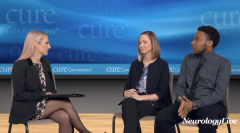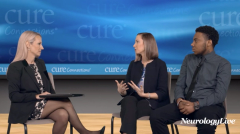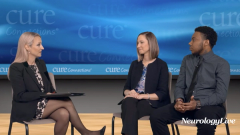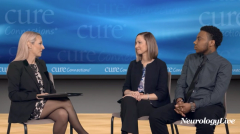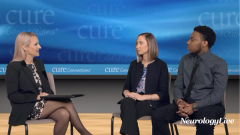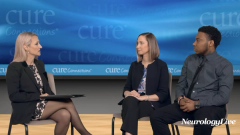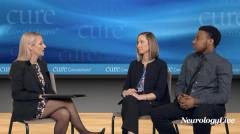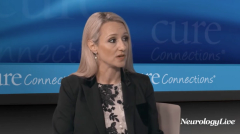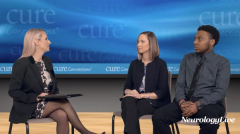
Treating Children and Spinal Tap Risks
Episodes in this series

Philippa Cheetham, MBChB, MRCS, MD, FRCS: Obviously you managed to convince Sebastian to go for this in the office. How do you get around this for younger children who clearly aren’t going to be able to lie on a bed and have a spinal infusion?
Crystal Proud, MD: They do amazingly well, let me tell you. For babies, their parents want this for them because obviously, they know that without treatment, they're going to lose their child. I think it becomes a totally different conversation when we're dealing with an infant. For my older patients, starting at the age of about 3, I think my patients really start having much more of a conversation about this. I've mentioned that the brain is not negatively impacted. My patients are very bright. And so my 3- and 4-year-old patients with SMA [spinal muscular atrophy] will tell me their opinions about what we're doing.
Philippa Cheetham, MBChB, MRCS, MD, FRCS: On the day, do you always succeed in getting the patient to lie there to get the spinal tap? You never have to resort to sedation or anesthesia?
Crystal Proud, MD: We started out with those 3- to 5-year-olds, trying some sedation. And what we found was that actually, our patients really did not like the IV [intravenous] placement for the sedating medicine. They preferred to be distracted. They will play music; as you know, we like to jam out a little bit. They can put on headphones. Many of them will play games on their phones, or they’ll watch TV through an iPad, or they'll watch a movie. Even the youngest patients tell me—3, 4, 5 years old—that they would really rather me just do a very quick spinal tap and get it done with, than have a bunch of IV pokes and medication, which can make you feel nauseous afterward. They don't want sedation. I do offer it if they would like it, though.
Philippa Cheetham, MBChB, MRCS, MD, FRCS: It's amazing. We've heard about some of the real improvements that you can get from these treatments. When you’re counseling parents and children about the risk of these treatments, what do you discuss? Obviously, the procedure itself, a spinal tap, is not child's play. Do you consult patients about the risk of the tap and what the downsides are of having these infusions?
Crystal Proud, MD: Yes, absolutely. We talk about both the lumbar puncture risks and the risks of medication. With the lumbar puncture, we talk about things like infection, which is why it's done as a sterile technique. We talk about the risk technically of bleeding, since I'm puncturing the skin, although I reassure them that the area that I'm going in is not highly vascular. We talk about the risk for post lumbar puncture headache.
Philippa Cheetham, MBChB, MRCS, MD, FRCS: That was my question.
Crystal Proud, MD: Although, I use an extremely small needle; I use a 22 gauge for most of my patients. And I'm reasonably good at what I do, so there is not a whole lot of wiggling around, which would leave a big tear in the dura mater, which usually is the culprit of those spinal headaches. My spinal headache incidence is incredibly low at this point.
Philippa Cheetham, MBChB, MRCS, MD, FRCS: After the spinal taps, were you straight back to normal living, or was there a period of 24 hours, 48 hours where you had to take it easy?
Sebastian Mills: The first time, I did have a little bit of soreness. But after that, once you get it, it's just like, “All right, I'm going to work.”
Crystal Proud, MD: Most of my patients will say, “I've got to get back to school.”
Philippa Cheetham, MBChB, MRCS, MD, FRCS: You never had any problems with headaches or any symptoms other than just local irritation from where the injection was?
Sebastian Mills: Yes, personally, I haven't had any symptoms. It was just, as you said, the lower irritation the first or second time. That's about it.
Philippa Cheetham, MBChB, MRCS, MD, FRCS: Now we've heard that this disease is not common. When you're treating patients like Sebastian, who is a great advocate for other patients who have been through these kind of treatments, do you get patients to talk to each other, to be advocates? Do you use people like Sebastian to egg on other patients to get treatment?
Crystal Proud, MD: I wish.
Philippa Cheetham, MBChB, MRCS, MD, FRCS: Does it work like that or no?
Crystal Proud, MD: HIPAA [Heath Insurance Portability and Accountability Act] kind of prevents me from doing that, although it is an incredibly small community. We actually have a Muscular Dystrophy Association clinic, and there’s a Muscular Dystrophy Association camp. Did you ever go to camp? I don't remember.
Sebastian Mills: I didn't go to camp.
Crystal Proud, MD: You didn't go to camp.
Sebastian Mills: I want to go to camp.
Crystal Proud, MD: You need to go back to camp. Several of my patients actually knew each other from camp days. And so I would encourage them to reach out to each other, but I'm not technically allowed to connect patients 1-to-1. Although I'm really fortunate that groups like Cure SMA, and there are some local Facebook groups that have allowed for a community to come together and to get corroboration about experiences through diagnosis and treatment, so that's been helpful.
Philippa Cheetham, MBChB, MRCS, MD, FRCS: Sebastian, we know that this is not a common disease, and yet, when you're talking to specialists like Dr Proud, it's what she does all day every day. What's it like when you talk to other doctors who don't have the knowledge about this disease? Do you find that you're having to educate them on what's actually been going on with you?
Sebastian Mills: I would say yes, and I think Dr Proud is awesome with that. She gives you the rundown of everything, so when you do come to people who you need to have the dialogue with and explain stuff to, it's easier for them to understand and be able to know where to navigate their research toward.
Philippa Cheetham, MBChB, MRCS, MD, FRCS: And to bring you back into the discussion, for patients like Sebastian who are interacting with doctors maybe through college, they're a long way from home. They're potentially a long way from a center of excellence. Do you give them advice on, “If you see other doctors, these are the kind of things that you need to warn them about?”
Crystal Proud, MD: Absolutely. So some of the things that you just alluded to, respiratory care is incredibly important. We know that the recommendation is that these patients receive their annual influenza vaccine. We give that in my clinic, but if for some reason they're not due in clinic during the season, then I would recommend that they receive that at their primary care doctor visit, and also that they stay up to date on all of the other routine vaccinations to prevent as much preventable disease as we possibly can, since they're at higher risk of hospitalization if one of these diagnoses impacts them.
Flu and pneumonia are incredibly different in a patient with SMA than in someone who does not have SMA and can actually land them in the hospital in the intensive care unit. And then, likewise, when we're thinking about respiratory insufficiency and the risks that go along with it, making sure that if a patient has something that takes them either to the emergency department for emergency surgery or even for a scheduled surgery, that they need to be advocates to speak to their anesthesiologist and say, “Hey, I have a motor nerve disease,” because that anesthesiologist may have a very different approach, pharmacologically with them than they would someone else.
Philippa Cheetham, MBChB, MRCS, MD, FRCS: Of course.
Newsletter
Keep your finger on the pulse of neurology—subscribe to NeurologyLive for expert interviews, new data, and breakthrough treatment updates.


